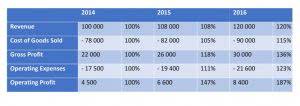Financial Accounting and Reporting Accounting and Financial Management AFM
Content

This information is used by both internal and external stakeholders, including investors, regulators and creditors. Financial statements must conform to accounting standards and legal requirements. In the U.S., the Small Business Bookkeeping Services Standards Board (FASB) establishes financial accounting and reporting standards (generally accepted accounting principles, or GAAP). Publicly traded companies must also comply with the requirements of the Securities and Exchange Commission. Stockholders, suppliers, banks, employees, government agencies, business owners, and other stakeholders are examples of people interested in receiving such information for decision making purposes.

Suppose a company pays a lot of money—for signing bonuses and so forth—to bring in a team of hot computer scientists who are central to its new strategy. Those costs are current expenses that have to be completely deducted from taxable income the year they’re hired, even though the business’s managers don’t expect to start getting value from them for at least another year or so. That may cause the firm to take a big hit to its income that year, and if it doesn’t have enough to cover the expense, the overall operation will appear to be losing money, a huge red flag for investors.
Principles of Financial Accounting
All the figures in the trial balance are rearranged to prepare a profit & loss statement and balance sheet. Accounting standards determine the format for these accounts (SSAP, FRS, IFRS). Financial statements display the income and expenditure for the company and a summary of the assets, liabilities, and shareholders’ or owners’ equity of the company on the date to which the accounts were prepared. On the other hand, International Financial Reporting Standards (IFRS) is a set of accounting standards stating how particular types of transactions and other events should be reported in financial statements.

This convention seeks to ensure that private transactions and matters relating to the owners of a business are segregated from transactions that relate to the business. Accountants do not account for items unless they can be quantified in monetary terms. Items that are not accounted for (unless someone is prepared to pay something for them) include things like workforce skill, morale, market leadership, brand recognition, quality of management etc.
Contents
We are actively seeking an experienced Financial Accountant to join our team. As a Financial Accountant, you will be responsible for monitoring all financial data, preparing accurate statements, and ensuring compliance with legal regulations. We can support you in building an effective and efficient finance function with a range of accounting, reporting and https://simple-accounting.org/understanding-the-cost-of-bookkeeping-for-small/ analytics services. Undergraduate and graduate students looking to enter business in general or finance in particular would also benefit greatly from this valuable course. The text links for self quizzing within each topic must be right-clicked and the user must choose to open each one in a new window or it is difficult to get back to the same place.
- Instead of waiting for cash to change hands, an accountant records income the moment the firm earns it, such as when the firm sends an invoice to a customer.
- Access to course materials and the course platform ends 60 days after the final deadline in the program.
- For example, the current ratio compares the amount of current assets with current liabilities to determine how likely a company is going to be able to meet short-term debt obligations.
- Journal entries are displayed in green bars that are easy to spot for refernece later.
- The trial balance, which is usually prepared using the double-entry accounting system, forms the basis for preparing the financial statements.
The true and fair view is applied in ensuring and assessing whether accounts do indeed portray accurately the business’ activities. A Financial Accountant works with senior managers as a consultant, collaborates with colleagues in finance and accounting departments, and may interact with auditors, tax professionals, and other stakeholders. This material has been prepared for general informational purposes only and is not intended to be relied upon as accounting, tax, or other professional advice. EY refers to the global organization, and may refer to one or more, of the member firms of Ernst & Young Global Limited, each of which is a separate legal entity. Ernst & Young Global Limited, a UK company limited by guarantee, does not provide services to clients.
Financial Accounting
The cash flow statement, also known as the statement of cash flows, documents in detail all of a company’s cash inflows and outflows over a specific period of time. The statement doesn’t account for depreciation and amortization costs or expenses financed with debt (like an income statement would). In this example, the debit and credit entries are equal and opposite, as the double-entry accounting system requires. By recording this transaction, ABC Inc. has recorded an increase in its revenue and assets. This information can be used to prepare financial statements such as income and balance sheets. The main purpose of accounting standards is to provide information to the user as to the basis on which the accounts have been prepared.
What is financial accounting and why?
The primary purpose of financial accounting is to document and record financial transactions, which is referred to as bookkeeping in accounting terms. Financial accounting is used by small business owners to document all of their company's commercial activities in the accounting ledger.
Some more current revisions in accounting standards are not addressed in this text, but these can be added or mentioned by the classroom instructor. The depth of the content for each subject area is very appropriate for a principles of accounting textbook and the text is very easy to read. Arguably, a number of rules have been prompting a major effort by companies to move work to nonemployees. Such costs are a big worry for investors because if business and revenue decline and those costs can’t be cut, the profitability and value of the business collapse in a hurry. The general ledger is also the source document for the financial statements.


Leave a Reply